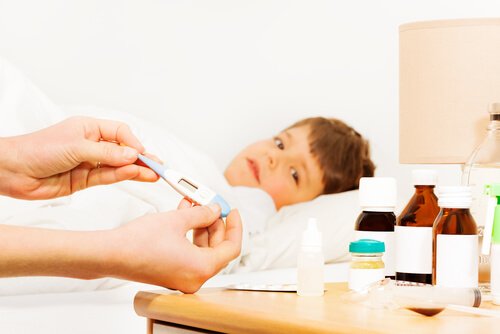5 Tips to Lower a Child's Fever

Knowing how to lower a child’s fever is a priority for parents. An uncontrolled fever can cause febrile seizures, and the risk is higher if the child suffers from a chronic disease. Once a fever passes 100.4 degrees Fahrenheit, parents must be very alert.
A fever is basically a symptom that tells us something isn’t working correctly. It’s usually activated by the presence of a virus or external infection that has entered the child’s body.
The good news is that there are many methods we can turn to when body temperature rises to unwanted levels and we need to lower a child’s fever. Next, we’ll see some practical, safe and natural tips that will be useful for parents.
Ways to lower a child’s fever
Use cold wash cloths
When the body temperature increases too much, the first step should be to lower it. One of the traditional tricks is to refresh the skin with a cold, wet wash cloth.
The cloths should be damp and cold, but not overly so. This will help to fight the malaise that the fever generates and will also help relieve a headache.
In addition, you can place the moist cloth on the back of the child’s neck and on his or her wrists. The cooling sensation will thus have a greater reach.
Bathe the child in warm water
Many mothers are afraid to bathe their children when they have a fever, but in reality a bath isn’t contraindicated. In fact, a bath can lower a child’s fever, but some guidelines should be followed.
The bathwater should be room temperature, a maximum of 93 degrees Fahrenheit. A shower can be given instead, but the effect is greater when the child is immersed in the water.

Remember that it’s important to avoid sudden changes in temperature with a child. The child should be wrapped up in a towel before and after the bath.
Drinking fluid helps overcome a fever
Whether the fever is caused by a virus or an infection, drinking fluids is the best way to achieve an improvement in the affected child. Remember that a fever results in a significant loss of fluids through sweat. This can lead to dangerous dehydration.
When your little one has a fever, he or she should consume plenty of water, soup and natural juices. In addition, the flow of liquid into the body will also have an internal cooling effect on the body.
Water is the body’s internal regulator. It supports the immune system in its fight against viruses. This vital fluid is the key to any recovery.
“Usually, the fever is activated by the presence of a virus or external infection that has entered the child’s body.”
Freshen the environment to lower a child’s fever
We often think that improvements can only be made by refreshing the child’s body. But the environment also has an important effect on a child’s fever.
When a child has a fever, parents must refresh their room. There must be air flow, bearing in mind that the child must be well covered. This will result in a more comfortable temperature for the child.
On the other hand, a hot climate in the room will only make things worse and increase the child’s internal temperature.

Alternate between sleep and movement
It’s important to try to make life as easy as possible when a child has a fever. Sleep is a recovery mechanism in both children and adults, so you must create the best conditions possible to help your little one sleep.
However, movement is also very positive, so get your child to walk a little bit in order to avoid being completely inactive. This small exercise will also help him or her sleep.
When a child’s fever exceeds 104 degrees Fahrenheit, it’s essential to go to the emergency room. If the fever is minor, you can lower it by refreshing, hydrating and facilitating rest for your little one.
Knowing how to lower a child’s fever is a priority for parents. An uncontrolled fever can cause febrile seizures, and the risk is higher if the child suffers from a chronic disease. Once a fever passes 100.4 degrees Fahrenheit, parents must be very alert.
A fever is basically a symptom that tells us something isn’t working correctly. It’s usually activated by the presence of a virus or external infection that has entered the child’s body.
The good news is that there are many methods we can turn to when body temperature rises to unwanted levels and we need to lower a child’s fever. Next, we’ll see some practical, safe and natural tips that will be useful for parents.
Ways to lower a child’s fever
Use cold wash cloths
When the body temperature increases too much, the first step should be to lower it. One of the traditional tricks is to refresh the skin with a cold, wet wash cloth.
The cloths should be damp and cold, but not overly so. This will help to fight the malaise that the fever generates and will also help relieve a headache.
In addition, you can place the moist cloth on the back of the child’s neck and on his or her wrists. The cooling sensation will thus have a greater reach.
Bathe the child in warm water
Many mothers are afraid to bathe their children when they have a fever, but in reality a bath isn’t contraindicated. In fact, a bath can lower a child’s fever, but some guidelines should be followed.
The bathwater should be room temperature, a maximum of 93 degrees Fahrenheit. A shower can be given instead, but the effect is greater when the child is immersed in the water.

Remember that it’s important to avoid sudden changes in temperature with a child. The child should be wrapped up in a towel before and after the bath.
Drinking fluid helps overcome a fever
Whether the fever is caused by a virus or an infection, drinking fluids is the best way to achieve an improvement in the affected child. Remember that a fever results in a significant loss of fluids through sweat. This can lead to dangerous dehydration.
When your little one has a fever, he or she should consume plenty of water, soup and natural juices. In addition, the flow of liquid into the body will also have an internal cooling effect on the body.
Water is the body’s internal regulator. It supports the immune system in its fight against viruses. This vital fluid is the key to any recovery.
“Usually, the fever is activated by the presence of a virus or external infection that has entered the child’s body.”
Freshen the environment to lower a child’s fever
We often think that improvements can only be made by refreshing the child’s body. But the environment also has an important effect on a child’s fever.
When a child has a fever, parents must refresh their room. There must be air flow, bearing in mind that the child must be well covered. This will result in a more comfortable temperature for the child.
On the other hand, a hot climate in the room will only make things worse and increase the child’s internal temperature.

Alternate between sleep and movement
It’s important to try to make life as easy as possible when a child has a fever. Sleep is a recovery mechanism in both children and adults, so you must create the best conditions possible to help your little one sleep.
However, movement is also very positive, so get your child to walk a little bit in order to avoid being completely inactive. This small exercise will also help him or her sleep.
When a child’s fever exceeds 104 degrees Fahrenheit, it’s essential to go to the emergency room. If the fever is minor, you can lower it by refreshing, hydrating and facilitating rest for your little one.
This text is provided for informational purposes only and does not replace consultation with a professional. If in doubt, consult your specialist.








